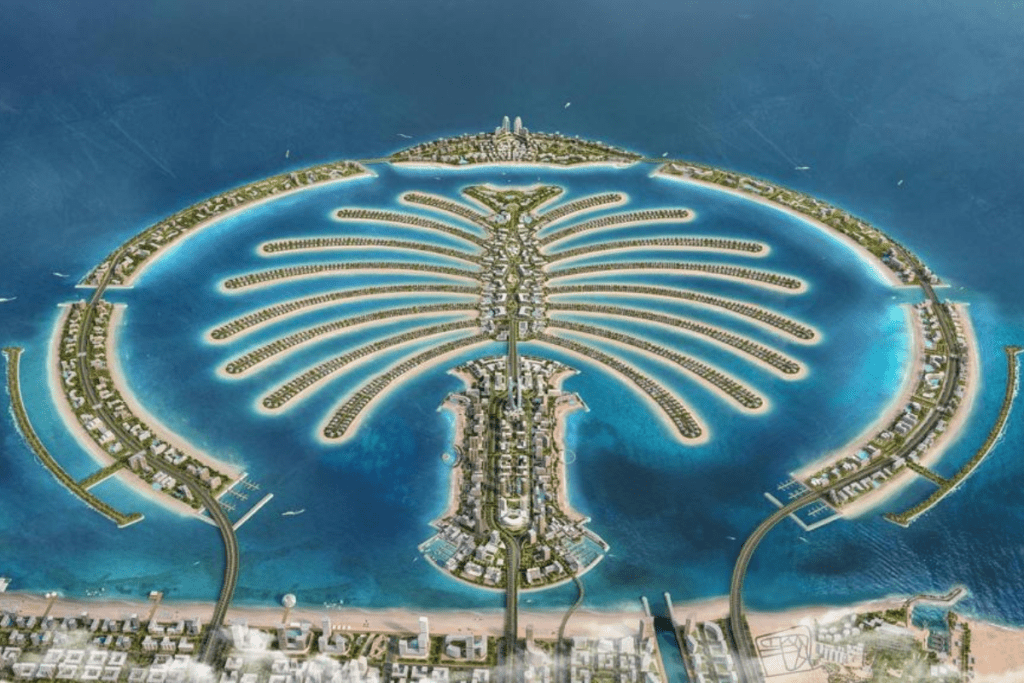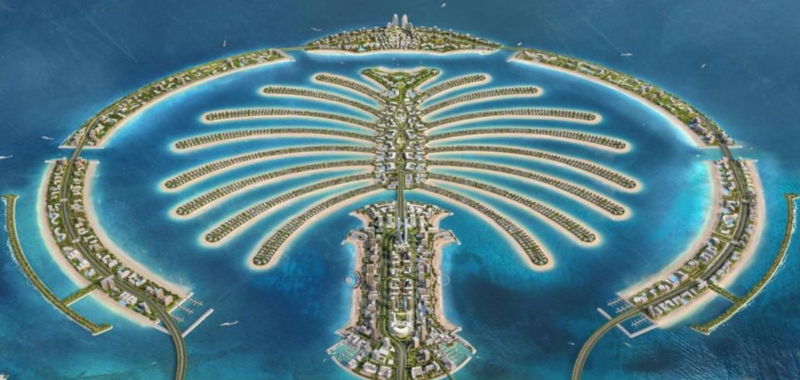
Skift Take
A combined 160 hotels are planned for Dubai Islands and Palm Jebel Ali.
For almost two decades, Dubai’s beachfront was something of a graveyard. Towards Abu Dhabi, you had the partially finished Palm Jebel Ali, which had been announced in 2002. Closer to the marina area, there was the struggling “The World” Islands, which dated to 2003. And towards Sharjah, Deira Islands (the 2004 project now known as Dubai Islands), seemed abandoned.
All three were victims of the 2008 financial meltdown.
Now the UAE has revived plans for them. Growth in Dubai’s hotel openings has been slow in recent years and the aim is to attract interest from developers to build these out as more millionaires flock to the city and tourism goals keep ratcheting up.
“If Dubai is going to be able to satisfy a [new] tourist flow, it’s going to be about beachfront hotels. And Palm Jebel Ali and Dubai Islands have got that,” said Knight Frank partner and regional hospitality head Daniel Pugh.
What Are Palm Jebel Ali and Dubai Islands Planning?
Palm Jebel Ali was revived in 2023 and hopes for 80 hotels upon completion. Dubai Islands was resurrected in 2022, and also plans 80 hotels.
If they hit these goals, they would add some 20% to Dubai’s supply, currently at 820. For now, though, only two hotels on Dubai Islands have opened, and there are no confirmed hotels for Palm Jebel Ali yet.
“It’s likely that a lot of [openings] will be in the five years. Maybe in the next two years or 18 months, we will start to see more concrete plans for when that supply is actually going live,” said Pugh.
The World hasn’t seen as much developer interest, but it has been slowly opening hotels since last year.
With more than 151,000 hotel rooms, Dubai has more keys than Las Vegas. But growth has slowed. Investment management company Colliers told Skift that over the next three to five years, growth is projected to be 2% to 5%, as opposed to 7.7% between 2016 and 2022.
According to industry tracking firm STR, Dubai will open 18 hotels and 6,000 hotel rooms this year, just over a 2% increase in supply. Next year will see another 17 hotels and 4,000 rooms on top of that.
Many luxury developers are waiting for Dubai’s revived man-made islands to be completed so they can continue to build lucrative beachfront hotels.
Colliers’ Nicolas Nasra, Head of Hotel Advisory, Hospitality & Tourism explained: “The lack of prime beachfront space is one contributing factor [to the slowdown in development]. Prime beachfront plots have become increasingly scarce for new luxury developments, and operators highly coveted these locations due to the premium guests are willing to pay for them. These two master plans [Dubai Islands and Palm Jebel Ali] will create new high-quality leisure destinations that appeal to luxury (and other) hospitality developments.”
Knight Frank’s Pugh said: “It may be some developers are taking a pause, but we know the government targets 25 million visitors by 2025, and to accommodate that, the hotel supply will need to swell once more. It’s coming, but we need to be patient.”
A Mid-market Boom at Palm Jebel Ali and Beyond
The supply influx from Dubai Islands and Palm Jebel Ali likely won’t be seen till the end of the decade or later. But when hotels do start to open, it is expected to signal a shift in Dubai towards more mass-market offerings alongside the luxury beachfront properties.
At the moment, 35% of Dubai’s are five-star and 29% are four-star.
“Dubai has to provide more price-sensitive rates. It’s all gearing up for that. There are plenty hotel operators with big brand families who have a lot of mid-market options to deploy,” said Pugh.
“There will be more of a range [at Palm Jebel Ali] since it is so much bigger than Palm Jumeirah. I think it will have a lot of mid-scale products. There is enough space for a range of products.”
Nasr also believed Dubai will enter a mid-market boom alongside the resurgence of the man-made islands. He said: “From a master plan perspective, Colliers anticipates further development announcements for hospitality projects on the Dubai Islands and Jebel Ali. Regarding standalone developments, we expect a surge in 3-star and 4-star projects over the next few years, including increased serviced apartment concepts and more affordable hospitality developments incorporating branded residences.”
Al Maktoum Airport
Beyond the islands, another tourism project is being revived, and it is Al Maktoum International Airport. Opened in 2010 but largely unused, Sheikh Mohammed announced a $35 billion expansion for the airport in April, turning it into the world’s biggest airport in the next 10 years.
Dubai ruler Sheikh Mohammed bin Rashid Al Maktoum said, âDubai will be the worldâs airport, its port, its urban hub, and its new global centre.â
Sheikh Mohammed has approved the designs for the new terminals at Al Maktoum International Airport, and greenlighted the commencement of construction for the project.
The airport would be able to accommodate 400 aircraft gates and feature five parallel runways.
Nasr said: “There is still an opportunity for new hospitality developments, such as 3-star and 4-star concepts that do not require prime beachfront or urban locations. Emerging urban master plans outside the prime destinations, such as the recently announced expansion to the airport in Dubai South, will create new opportunities for developers and operators, further diversifying Dubai’s hospitality offerings.”

